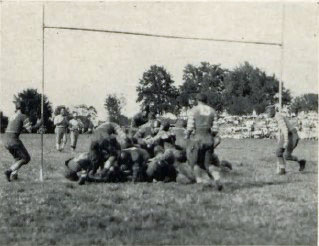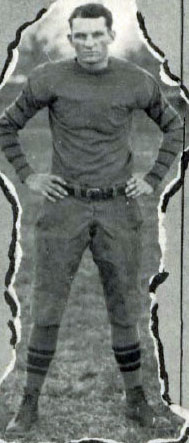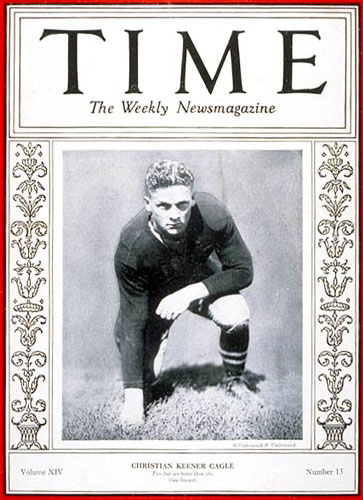LSU Pivotal Football Moments
pivotal college football moment: A decision by a coach or athletic director that changes the momentum of a program or an action by a player that changes the momentum of a game.
pivotal college football moment: A decision by a coach or athletic director that changes the momentum of a program or an action by a player that changes the momentum of a game.
A native of Ireland and a Yale graduate, Mike Donahue became the LSU coach in 1923 after 16 seasons at Auburn. His record was 99-35-5 and included six first place finishes in the Southern Intercollegiate Athletic Association. Sportswriter Fuzzy Woodruff described Donahue as "a mouse-like little man [he was only 5'4"] with little to say, save when aroused, on which he was capable of utterances of great fire and fervor."
In the four years that Donahue played quarterback at Yale under the legendary Walter Camp, the Eli won 45 games while losing just two.
So desperate was LSU to excel on the gridiron that they gave Donahue a five-year contract that paid him $10,000 a year, which was more than the governor of Louisiana.
LSU's Gumbo Yearbook called Donahue "undoubtedly one of the best in the country as a football mentor ..." But the writer cautioned: "New football material, combined with the lack of a sufficient number of experienced backfield men to give poise to the team, made it impossible for 'Mike' Donahue to turn out a successful grid eleven in his first year at L.S.U."
Donahue's signature offensive formation was the "line-divide." In his book The Fighting Tigers II, Peter Finney described the formation this way:
Donahue's "line-divide" baffled the opposition for years (Auburn was using it in 1910) before the enemy learned to concentrate four or five good linemen in front of the "I" made by two halfbacks, the fullback, and the quarterback, who lined up Indian file behind the center. On "line-divide-right" there was an end and a guard to the left of the center. Immediately to the center's right there was a gap of three and a half yards. In this gap, just off the line of scrimmage, were the two tackles. To their right, on the line, was a guard and an end. On the shift, both tackles moved into the line, leaving a split of some two yards. In the backfield, the quarterback would shift to a spot just behind the gap between the tackles; the right half, to a wingback spot; the fullback, to a spot behind the quarterback; the left half, to a tailback's spot. All signals were called by the quarterback, the numbers designating the players and where they were to go.
Donahue's first LSU team defeated Louisiana Normal (today's Northwestern State)
40-0 in their opener. The next opponent was considered another example of what almost a century later would be labeled a "rent-a-win."
40-0 in their opener. The next opponent was considered another example of what almost a century later would be labeled a "rent-a-win."
Coach T.R. Mobley's Bulldogs had two games under their belts, both road losses to Centenary 35-0 and Tulane 20-2. You couldn't blame the Tigers for taking the visitors lightly, but doing so almost led to an embarrassing loss. SLI had a "secret weapon" in the person of a 5'9" 150lb dynamo named "Red" Cagle.
Christian Keener Cagle, one of eight children, starred in football and track for Merryville High School near the Texas border west of DeRidder. The 5'9" 150lb dynamo took his talents to Southwestern Louisiana Institute in Lafayette where he could study forestry. Since SLI did not adhere to the widespread agreement among colleges to make athletes sit out their freshman year, he immediately joined the SLI varsity for the 1922 season and immediately had an impact.


L: Mike Donahue; R: LSU-SLI action (LSU Gumbo Yearbook Class of 1924)
Walter Schwam's game article in the New Orleans Item the next day began like this:
Louisiana State's Tigers almost came to disaster here this afternoon when an outfit of husky red jerseys named Southwestern Louisiana Institute but unheralded and unknown, outclassed and completely outplayed the purple jerseys of the "ole war skule" for three quarters only to fall before indomitable Tiger spirit 7 to 3 in the fourth period.
LSU started strong as burly junior FB Augustus "Stonewall" Jackson from Lecompte LA and Norman Stevens (Picayune MS) hammered the left side of the Bulldog line. But another theme for the game set in as LSU stopped itself with a turnover, an interception by Alton Bujard on SLI's 35.
Cagle unleashed an aerial barrage, completing an unheard of 20 passes in the game. Three went to G. Trahan and another to B. J. Cambre for a total of 23y. But a second down incompletion and two short runs forced Cagle to punt to the eight.
Following the prevalent startegy of the day–I'd rather you have the ball in your territory than I have the ball deep in my end–Stevens boomed a 50y punt "out of danger."
But the Bulldogs drove right back into Tiger territory as Cagle completed four passes in succession to gain three first downs and put the ball on LSU's 10. Then a fumble lost 2y before Cagle was thrown for a 4y loss. So Maxie Landry tried a dropkick field goal from the 25 that missed as the Tiger fans breathed a sigh of relief.
Neither team threatened again, and the first half ended scoreless.



L-R: Gus Jackson, Norman Stevens, Louis Abramson (LSU Gumbo Yearbook Class of 1924)
SLI Breaks Scoring Ice
Cagle led the Bulldogs down the field in the first three minutes of the third quarter with passes to FB Bujard and ends G. Trahan and W.A. Ruger. The longest completion was 40y to E.J. Richardson to put the ball on the LSU 25. Most of Red's throws were hurled from 10 to 15y behind the line of scrimmage after the redhead dodged rushers. Several times, the last LSU defender made a touchdown-saving tackle on the receiver. That was crucial as the Tigers finally forced a field goal try from the 20. This time, Landry dropkicked the pigskin through the uprights for a 3-0 SLI lead.
Fumbles Frustrate Tigers
The Tiger offense, stifled during the first half, finally started moving on line bucks. But after reaching midfield, a fumble gave SLI the ball. Later in the period and again early in the fourth quarter, LSU moved across midfield only to lose fumbles each time.
Landry got a third try at a field goal following LSU's second fumble of the half. Bujard took a short pass and sprinted 30y before he was downed. But the Tigers twice dropped ball carriers for losses to force another three-point try. But T Clyde "Red" Hughes from Baton Rouge broke through and blocked the kick and fell on the ball.




L-R: Chris Cagle, Alton Bujard, B. J. Cambre, Maxie Landry
Cagle from US Military Academy Howitzer Yearbook Class of 1928
Other three from Southwestern Louisiana Institute L'Acadien Yearbook Class of 1926
Jackson Leads Do-or-Die Drive
LSU finally started a drive from their 20 with six minutes left in the game. Jackson did most of the work, gaining 56 of the 80y. Two big gains came on passes from Louis Abramson (Shreveport) to Jackson for 20 and then 25y. The drive ended on 4th and goal from the two when big Gus drove outside left tackle into the end zone. Abramson drop-kicked the extra point. LSU 7 SLI 3
The Tigers fended off Cagle's last-ditch effort, taking over on downs and running out the clock.
FINAL SCORE: LSU 7 SLI 3
Chris Cagle would have one of the most interesting careers of any football player. After four years at SLI, he played another four years at West Point (1926-29). That put him in the national spotlight, resulting in his being chosen as an All-American three straight years and making the cover of Time magazine. He was noted for playing with a loose chin strap and sometimes without a helmet.
He played professional football with the New York Giants (1930-32) and Brooklyn Dodgers (1933-34) and became a co-owner of the Brooklyn team.
Cagle suffered a tragic death at age 37. He fractured his skull when he tripped and fell down a flight of subway steps in New York City.
He was inducted posthumously into the College Football Hall of Fame in 1954.
Reference: Red Cagle: West Point's Three-Time All-American, Cathy C. Post (2019) |
 |